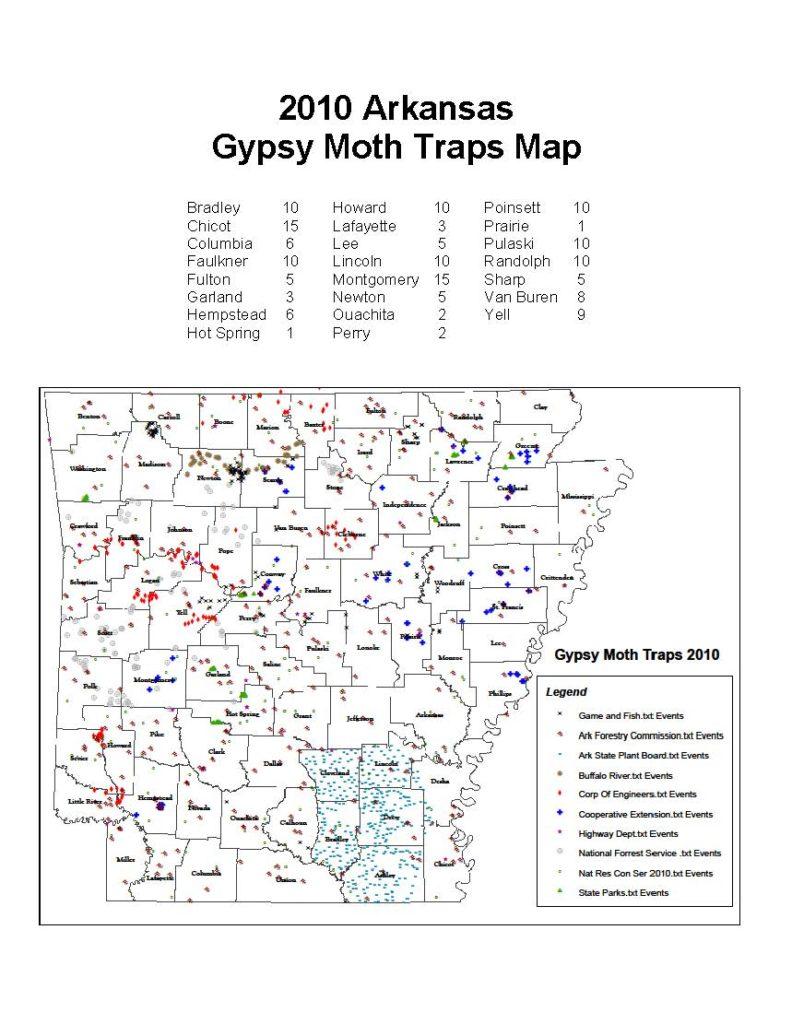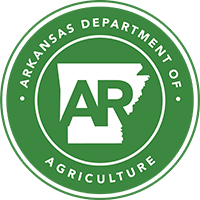Plant Industries
Serving the citizens of Arkansas and the agricultural and business communities by providing information and unbiased enforcement of laws and regulations set by the Arkansas State Plant Board
Agriculture / Plant Industries / Regulatory Section / Ag Pest Survey Program / The 2010 Arkansas Gypsy Moth Report
The 2010 Arkansas Gypsy Moth Report
Scott Bray, Director, Plant Industry Division
Paul Shell, Plant Inspection and Quarantine Manager
The Gypsy Moth Detection Survey Plan for Arkansas has been developed through the joint efforts of the Arkansas State Plant Board, the U.S. Forest Service and the USDA APHIS Plant Protection and Quarantine. The plan follows the guidelines of the National Gypsy Moth Survey Plan.
Arkansas’s plan three distinct parts:
- 1st part is detection traps which are deployed all over Arkansas by our cooperating agencies, the Plant Board, and USDA APHIS PPQ.
- 2nd part is delimiting trapping in high risk areas (those areas where there were catches the previous year).
- 3rd portion of the overall plan is the delimiting trapping in the eradication zone. This method will not be used unless we find another breeding population.
This summer’s gypsy moth plan is always based on results from the previous year. The following is a recap of 2009 and then the results of the 2010 trapping and quarantine programs.
Summer 2009 Delimiting Trap Results
Delimiting trapping is performed in areas where positive catches have been made in the past. This method is used to determine if there is a breeding population in this area, or if the previous catch was a hitchhiker. The zone is considered moth free when two years pass without a catch. Traps are placed at a rate of 36/ sq. mile centered where the positive catch occurred. As there have been no moth catches in the past 6 years, there has been no delimiting programs in the past 5 years. This will resume when moths are caught in the future.
The year-to-year gypsy moth effort is built around our detection trapping program. We coordinate the services of 14 cooperating agencies. They carry out a planned network of trapping which blankets the whole state. This is the initial and most vital defense against this pest, providing us crucial early detection information of potential problems. We wish to thank all of our cooperators for their hard work in placing and picking up these traps.
These key agencies, listed below, are responsible for deploying 2400 traps.
| Agency | |
| Arkansas Dept. Of Parks and Tourism | 375 |
| Arkansas Game and Fish Commission | 150 |
| Arkansas Forestry Commission | 350 |
| Camp Robinson Army Base | 75 |
| Corp. of Engineers - Little Rock District | 550 |
| Arkansas Cooperative Extension Service | 375 |
| Arkansas Highway Dept. | 75 |
| Natural Resources Conservation Service | 250 |
| US Forest Service - Ouachita | 100 |
| US Forest Service - Ozark | 50 |
| Buffalo National River | 50 |
Although there were many moth specimens submitted for identification no gypsy moths were found through our cooperating contributors.
USDA APHIS PPQ, and the Plant Board also did extensive trapping in North-West Arkansas and South-Central Arkansas. Approximately 2,800 traps were placed in a grid pattern approximately 2 miles apart.
2010 Delimiting Trapping
In addition to detection trapping, delimiting trapping is an effective tool to combat the spread of Gypsy Moths. Delimiting traps are set in response to a catch within the past 2 years and are deployed in such a way as to better define the status of a potential gypsy moth population. No delimiting trapping was performed due to no moth catches since 2004. These will resume when moths are caught at a rate of 36 traps per square mile centered where the positive catch was found.
The 2011 Delimiting Plan
There are no delimiting areas for 2011 as the previous catches have turned up negative for the previous two years.
Conclusion
We are proud to announce that no moths were caught in 2010. This is the sixth year in a row that no moths have been caught. This is very encouraging and points out that everyone’s hard work has been worth it. It is, however, no reason to let our guard down. Detection surveys will continue with the able assistance of our cooperating agencies, and USDA. In this upcoming year, we’ve been instructed to have all traps in place by the end of May. Entomologists have informed us that the Gypsy Moth may emerge from the egg masses earlier than we have expected due to our location further south than the main population of this pest.
The states closer to the gypsy moth infestations are continuing their work in slowing the spread of this invader. The Plant Board looks for gypsy moth egg masses on cut Christmas trees which originate in areas where gypsy moths are a problem. Also, there are some pathogens which are impacting the populations of gypsy moths in infested areas. Perhaps this potential threat will never reach us. Extensive trapping is the best way to monitor the population and determine if other action needs to be taken.
2010 Traps Map
The following map show locations where traps were placed in 2010. These were the traps placed by Cooperators and Arkansas State Plant Board. This does not show the location of traps placed by USDA. In addition, several traps were placed by cooperators with no GPS data included. These are listed by county.


